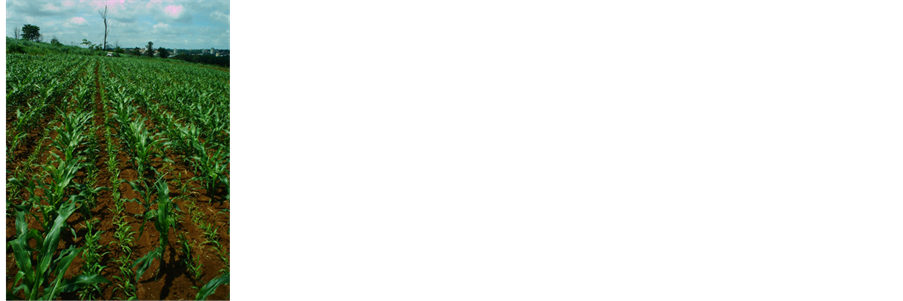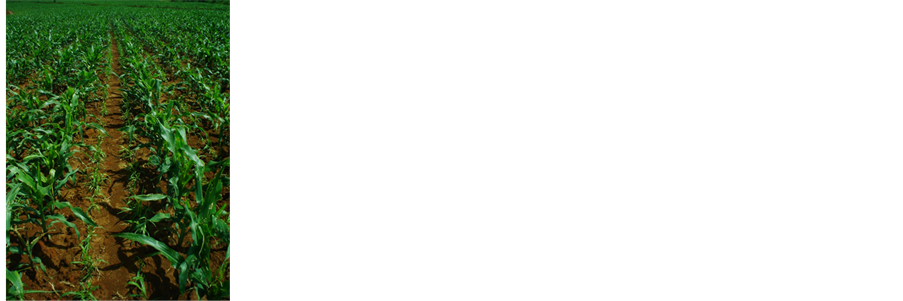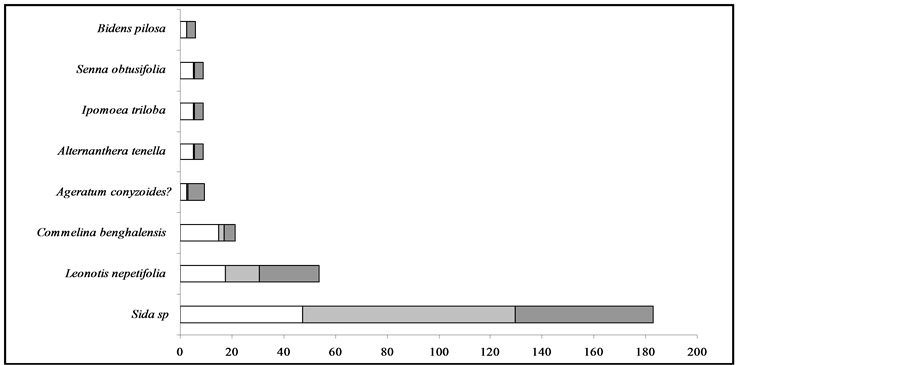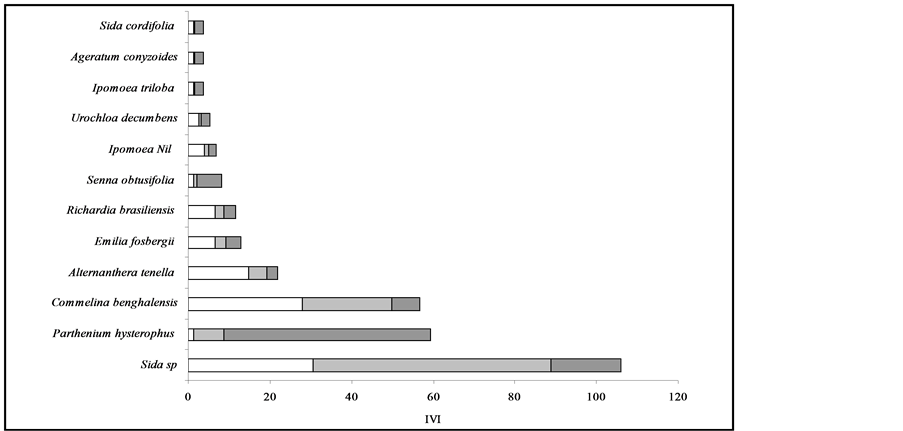American Journal of Plant Sciences
Vol.5 No.8(2014), Article ID:44204,8 pages DOI:10.4236/ajps.2014.58121
Phytosociological Survey of Weeds in Areas of Crop-Livestock Integration
Karina Batista*, Alessandra Aparecida Giacomini, Luciana Gerdes, Waldssimiler Teixeira de Mattos, João Batista de Andrade
Instituto de Zootecnia, Agência Paulista de Tecnologia dos Agronegócios, Nova Odessa, Brazil
Email: *batistakarin@gmail.com
Copyright © 2014 by authors and Scientific Research Publishing Inc.
This work is licensed under the Creative Commons Attribution International License (CC BY).
http://creativecommons.org/licenses/by/4.0/


Received 21 January 2014; revised 23 February 2014; accepted 9 March 2014
ABSTRACT
The dynamics of the weeds in the areas of crop-livestock integration is constantly changing depending on the various uses of the area. This study identified and quantified the floristic composition of weeds in areas of integration of maize for silage with Urochloa ruziziensis cv. Common at different densities of grass (0, 4 and 10 kg∙ha−1) to grazing of beef cattle. The experimental design was completely randomized. A square of side 0.5 m (0.25 m2 area) was launched 24 times in each study area. The survey was conducted at the grain filling stage of maize. The specie contained in each frame were identified and counted. The phytosociological survey identified 9 families of weeds in areas assessed, with 7 families in every area of integrated cultivation maize with Urochloa ruziziensis at densities of 10 kg∙ha−1 and 4 kg∙ha−1 and 8 families in the area of maize cultivated alone. The Asteraceae family was the most represented in number of species. Sida spp (Malvaceae) showed greater potential to cause damage to maize. Urochloa ruziziensis at planting density of 10 kg∙ha−1 provided greater competition with weeds in the integration with maize.
Keywords:Asteraceae; Crop-Livestock System; Forage; Silage; Weed Species

1. Introduction
The dynamics of occurrence of weeds was changed with the advancement of the concepts of use of agricultural areas, from monocultures with soil preparation to crop rotation, tillage and crop-livestock integration because in these areas the environment is constantly changing according to its use. In this diversity of cultures and weed species is needed to understand which species can cause problems to focus on control techniques in the management of these species as well as knowing which the weeds companions of the system, and no more alone [1] .
In this context the phytosociological survey of the weed community is critical, because it can help to define what to do (how and when) in relation to the management of weeds in the crop-livestock system, since possible conditions of infestation and management are varied [2] .
Several authors reported that in the agricultural productivity losses, on average, caused by weeds are in the order of 30%, against 25% for diseases of cultivated plants, 15% for animal diseases, 14% for soil erosion and 10% for attacks from insects to crops. The crop-livestock integration seeks to intensify land use by using diversification with other practices, such as crop rotation, tillage, use of improved genotypes which has allowed greater sustainability of the agroecosystems [3] .
The control of weeds in maize is by chemical method predominantly, due to efficiency, speed of operation and cost savings. Atrazine is the main herbicide used in maize, its application is held in the early maize development, and in pre-or post-emergence of weeds. However in crop-livestock integration, the use of this herbicide only in one application may not be enough, because the weeds are important even after the critical period of competition with annual crop and it is not interesting that the chosen forage it develops under high infestation levels of weeds [4] .
Although the activities of grazing cattle in winter in the crop-livestock system have little influence on the composition of weeds species, in the phase of integration between cover crops and annual crops such interaction probably occurs and thus suppression of weeds system. The wider adoption of integrated crop-livestock systems should reduce reliance on herbicides in comparison with other conventional systems [5] .
Studies demonstrated the importance of forages in controlling weeds [6] -[8] . In the integration of maize with forages, Urochloa decumbens reduced slightly the weed infestation and Urochloa brizantha was the most efficient in the reduction of Ipomoea grandifolia (Convulvolaceae) [6] . Moreover, the integrated cultivation of Urochloa brizantha with maize under a system of crop-livestock integration promoted greater long-term control of Bidens pilosa (Asteraceae) [7] .
The Urochloa ruziziensis has been featured in crop-livestock integration for presenting great phenotypic plasticity, shade tolerance and acceptability by cattle compared to other species of the genus Urochloa [8] . Therefore this study identified and quantified the floristic composition of weeds in areas of integration of maize for silage with Urochloa ruziziensis cv. Common at different planting densities to grazing of beef cattle.
2. Materials and Methods
The phytosociological study of weed was conducted during 2010-2011 in areas of integration of maize for silage with Urochloa ruziziensis cv. Common at different planting densities in Nova Odessa (latitude 22˚42′S, longitude 47˚18′W and elevation 570 m), Brazil, in an Alfissol [9] . The climate is hot and humid, with a rainy season in summer and dry in winter, with the coldest month of the year temperature below 18˚C.
The study areas consisted of: 1) Maize integrated with two lines Urochloa ruziziensis at planting density of 10 kg∙ha−1; 2) Maize integrated with two lines of Urochloa ruziziensis at planting density of 4 kg∙ha−1 and 3) Maize cultivated alone (Figures 1(a)-(c)). The cultivar used was the simple hybrid IAC8390. The experimental design was completely randomized, and each experimental area consisted of 6 m2. Maize was used for silage and Urochloa ruziziensis cv. Common was used to grazing of beef cattle.
Maize and Urochloa ruziziensis were seeded simultaneously in the same activity for the implementation of the integration. In the planting was used a no-tillage system planter with additional housing for planting Urochloa ruziziensis. The spacing between the rows of maize was 0.80 m. Two lines Urochloa ruziziensis were implanted between rows of maize.
In the sowing of maize was distributed about five seeds per meter. The cultural value of Urochloa ruziziensis seeds was 60%. During the planting and topdressing took care to provide nutrients just for the maize crop. In planting fertilization was used about 360 kg∙ha−1 of the formula 08-28-16+ Zn and topdressing 300 kg∙ha−1 of 20-00-20 formula.
The weed management in the areas of integration of maize with Urochloa ruziziensis and maize cultivated alone was done with pre-emergent herbicides and post-emergent selective to maize crop. However, we chose not to use herbicide (nicossulfuron) to contain the growth of grass.
The weeds were evaluated at the grain filling stage of maize. In the survey was used a square of side 0.5 m (0.25 m2 area) which was launched 24 times in each study area. This procedure was done in a random manner
 (a)
(a) (b)
(b) (c)
(c)
Figure 1. Integration areas of maize with Urochloa ruziziensis at different planting densities 10 kg∙ha−1 (a), 5 kg∙ha−1 (b) and maize cultivated alone (c) at 27 days after planting.
[2] . The species contained in each frame were identified [10] , cut close to the ground and separated into monocots and dicots.
Frequency, relative frequency, density, relative density, abundance, relative abundance and relative importance index were then calculated by formulas: [Frequency = number of squares containing species/total number of squares; Relative frequency = 100 × (frequency of the species/total frequency of all species); Density = total number of individuals per species collected/total area; Density = 100 × (density of species/total density of all species); Abundance = total number of individuals per species/total number of squares containing the species; Relative abundance = 100 × (species abundance/total abundance of all species); Value index importance (IVI) = relative frequency + relative density + relative abundance] [11] .
The Similarity Index Sorensen (SI) was used to assess similarity between populations botanical (estimate of the degree of similarity in species composition) by a formula [SI = (2a/b + c) × 100 and a = the number of common species in both areas; b and c = total number of areas in the two species compared]. The SI ranges from 0 to 100, with maximum when all species are common to both areas and minimum when there are no species in common [2] .
3. Results and Discussion
The phytosociological survey identified 9 families of weeds in areas assessed, with 7 families in every area of integrated cultivation maize with Urochloa ruziziensis at densities of 10 kg∙ha−1 and 4 kg∙ha−1 and 8 families in the area of maize cultivated alone (Tables 1-3). The most representative family in phytosociological survey, with regard to the number of species, was Asteraceae (6) followed by Malvaceae (4), Amaranthaceae (3), Commelinaceae (3), Leguminosae (3), Poaceae (3), Convulvolaceae (2), Lamiaceae (2) and Rubiaceae (1). The families of species found resemble those identified by other authors in areas of maize integrated with Urochloa spp [6] -[8] .
In all areas assessed occurred predominantly broadleaved weeds (dicots). The coexistence in an agroecosystem physiology of plants showing similar growth promotes more intense interspecific competitive relationships, which may explain these results [12] . Moreover the weed species belonging to the family Poaceae are more sensitive to the effects of straw [13] .
Only maize integrated with Urochloa ruziziensis at density of 10 kg∙ha−1 showed Echinochloa colona (L.) Link (Poaceae) and Digitaria horizontalis Willd. (Poaceae) monocot weeds. The values of abundance, density and frequency in these weeds were lower compared to other weed species in this area (Table 1). The Digitaria horizontalis (Poaceae) is one of the most frequent species in agricultural environments [13] . Another important aspect was that only in this area not occur the presence of Senna occidentalis (Leguminosae) a weed considered toxic to cattle and other grazing animals in grass, with the main symptoms of poisoning in cattle: diarrhea, weakness, tremor and imbalance [14] . This observation is very important, considering that after harvest of corn for silage, the Urochloa ruziziensis is used as pasture in crop-livestock system.
The results of abundance, density and frequency observed in Tables 1-3 demonstrated that the association
Table 1 . Phytosociological parameters identified by species, family and class in maize area integrated with Urochloa ruziziensis at density of 10 kg∙ha−1.
A: abundance; D: density and Fr = frequency.
Table 2. Phytosociological parameters identified by species, family and class in maize area integrated with Urochloa ruziziensis at density of 4 kg∙ha−1.
A: abundance; D: density and Fr = frequency.
Table 3. Phytosociological parameters identified by species, family and class in maize area cultivated alone.
A: abundance; D: density and Fr = frequency.
between Urochloa ruziziensis and maize promoted by crop-livestock system affected the germination potential of the seed bank of weed community, triggering changes in their population dynamics and spatial distribution [5] .
The values of weed density observed for the integration of maize with Urochloa ruziziensis at density of 10 kg∙ha−1 (Tables 1-3) indicated that the largest number of forage plants per meter due to the larger amount of seeds grass, provided greater ground cover and, consequently, fewer weed plants per area.
This increased number of plants of Urochloa ruziziensis at density of 10 kg∙ha−1 also increased soil exploration (surface and volume) and, consequently promoted greater competitive effect on weeds [8] . One can also infer that rapid and excellent ground cover promoted by Urochloa ruziziensis in this density allowed lower incidence of direct sunlight and this contributed negatively in the emergence and spread of weeds especially positive photoblastic [15] .
The colonist species Echinochloa colona (Poaceae) and Digitaria horizontalis (Poaceae) for integration maize with Urochloa ruziziensis at density of 10 kg∙ha−1, the species Ageratum conyzoides (Asteraceae ) and Bidens pilosa (Asteraceae) for integration maize with Urochloa ruziziensis at density of 4 kg∙ha−1 as well as the species Emilia fosbergii, Ageratum conyzoides (Asteraceae ); Ipomoea triloba (Convulvolaceae), Senna obtusifolia (Leguminosae) and Sida cordifolia (Malvaceae) in growing maize cultivated alone are probably distributed in localized spots (Tables 1-3) [11] .
The weed species with low frequency may, in some cases, waive the application of herbicides for the control in the whole area, as normally occur in focus and thus localized control could avoid its development, seed production and subsequent proliferation [11] . In addition, the located control may be an alternative to reducing the production cost.
The importance value index indicates which species have greater influence within a community [2] suggesting that Sida spp (Malvaceae) can be considered a nuisance species with the greatest potential to cause damage to the culture of the maize (alone or integrated) regarding the others weeds (Figures 2(a)-(c)). This fact highlights the need for strategies this species in all areas of study, because if not controlled properly, Sida spp (Malvaceae) besides competing for water, light and nutrients can interfere with harvest and be host to many insect pests [16] .
There are reports that Sida spp (Malvaceae) can produce up to 28.200 seeds∙m−2 in a single cycle of summer like weed. It is a weed specie in several crops, including grazing, and their presence also hinders mechanized harvesting annual crops, since it has a very sturdy stem [17] . The deep and aggressive root system, field observations have linked the frequent presence of this weed in soils with a high degree of compression [13] .
Alternanthera tenella Colla (Amaranthaceae) was the second species of greatest importance value index (IVI = 88) after Sida spp (Malvaceae) in the integration of maize with Urochloa ruziziensis at density of 10 kg∙ha−1 This species develops forming large colonies in cultivation and pasture areas due to its easy propagation and growth increment. While spreading by means of seed, the plant can be easily spread through the rooting along the nodes of the branches [18] . Featuring extensive soil cover, thereby inhibiting the growth of other plants [19] .
Leonotis nepetifolia (L.) R. Br. (Lamiaceae) is the second largest species of importance value index (IVI = 54) after Sida spp (Malvaceae) in the area of integration of maize with Urochloa ruziziensis at density of 4 kg∙ha−1. However this species did not show a logical pattern of behavior in four years of reviews of weeds in no-tillage with different crop rotation including maize system [13] .
The plants of the Lamiaceae family it belongs to the species Leonotis nepetifolia (Lamiaceae) are characterized by having wide variance as to the requirements necessary for seed germination and also some initial numbness soon after ripening of its fruit, a fact that may have contributed to its index value of importance in the area of integration of maize with Urochloa ruziziensis at density of 4 kg∙ha−1 [20] .
Alternanthera tenella Colla (Amaranthaceae) and Commelina benghalensis L. (Commelinaceae) had higher importance value (59 and 57 respectively) after Sida spp (Malvaceae) in the area of maize cultivated alone. It is noteworthy Commelina benghalensis L. (Commelinaceae) spreads through fragmentation of the rhizome and aerial stem and sometimes by seed [18] .
The similarity index may be considered high when it exceeds 50% [2] . Thus for this study, this index showed high similarity (SI = 70.6%) in the areas of maize integration with Urochloa ruziziensis at densities of 4 and 10 kg∙ha−1 (Table 4). This result pointed out that production systems that use the techniques of crop-livestock are important in the management of weeds, since they promote the reduction of the emergence of some species, but that the adoption of practices of parallel control is necessitated by system at the same time select the most
 (a)
(a) (b)
(b) (c)
(c)
Figure 2. Importance value index of weed in the areas of integration of maize with Urochloa ruziziensis at different planting densities 10 kg∙ha−1 (a) 5 kg∙ha−1 (b) and maize cultivated alone (c).
Table 4. Similarity index (SI) of weed communities occurring in maize integrated with Urochloa ruziziensis at different seeding densities.
aggressive species.
The low similarity observed between areas maize cultivated alone and maize integrated with Urochloa ruziziensis at density of 10 kg∙ha−1 (SI = 38.1%) highlights the importance of soil cover in weed control, since it is understood that the integrated maize crop with tropical forages can decrease the incidence of weeds due to the high biomass production and allelopathy provided by surface deposition of straw on the ground. The similarity index showed that maize cultivated alone didn’t produce sufficient straw to inhibit the proliferation of weeds (Table 4).
4. Conclusion
The Asteraceae family was the most represented in number of species. Sida spp (Malvaceae) showed greater potential to cause damage to maize. Urochloa ruziziensis at planting density of 10 kg∙ha−1 provided greater competition with weeds in the integration with maize.
References
References
Ciuberkis S., Bernotas S., Raudonius S. and Felix J. (2007) Effect of Weed Emergence Time and Intervals of Weed and Crop Competition on Potato Yield. Weed Technology, 21, 2013-218. http://dx.doi.org/10.1614/WT-06-101.1
Oliveira A.R. and Freitas, S.P. (2008) Levantamento fitossociológico de plantas daninhas em áreas de produção de cana-de-açúcar. Planta Daninha, 26, 33-46. http://dx.doi.org/10.1590/S0100-83582008000100004
Pelissari, A. Mendonça, C.G., Lang, C.R. and Balbinot Junior, A.A. (2011) Avanços no controle de plantas daninhas no sistema de integração lavoura-pecuária. Synergismus Scyentifia, 6, 1-16.
Braga, R.R. Cury, J.P., Santos, J.B., Byrro, E.C.M., Silva, D.V., Carvalho, F.P. and Ribeiro, K.G. (2012) Ocorrência de plantas daninhas no sistema lavoura-pecuária em função de sistemas de cultivo e corretivo de acidez. Revista Ceres, 59, 646-653. http://dx.doi.org/10.1590/S0034-737X2012000500010
Tracy B.F. and Davis, A.S. (2009) Weed biomass and Species Composition as Affected by an Integrated Crop-Livestock Systemcrop Science. Crop Science, 49, 1523-1530. http://dx.doi.org/10.2135/cropsci2008.08.0488
Severino, F.J. Carvalho, S.J.P. and Christoffoleti, P.J. (2006) Interferências mútuas entre a cultura do milho, espécies forrageiras e plantas daninhas em um sistema de consórcio. III—Implicações sobre as plantas daninhas. Planta Daninha, 24, 53-60. http://dx.doi.org/10.1590/S0100-83582006000100007
Bulegon, L.G. Castagnara, D.D., Berté, L.N., Oliveira, P.S.R. and Neres, M.A. (2012) Efeito do consórcio de milho com Brachiaria brizantha em diferentes taxas de semeadura sobre a incidência de ervas daninhas. Cultivando o Saber, 5, 72-86.
Gimenes, M.J. Dal Poggeto, M.H.F.A., Prado, E.P., Christovam, R.S., Costa, S.Í.A. and Souza, E.F.C. (2011) Interferência de Brachiaria ruziziensis sobre plantas daninhas em sistema de consórcio com milho. Revista Caatinga, 24, 215-220. http://dx.doi.org/10.5433/1679-0359.2011v32n3p931
EMBRAPA (1999) Sistema brasileiro de classificação de solos. 1 Edição, Embrapa Produção de Informação, Brasília.
Lorenzi, H. (2006) Manual de identificação e controle de plantas daninhas: Plantio direto e convencional. 6 Edição, Instituto Plantarum, Nova Odessa.
Brighenti, A.M. Castro, C., Gazziero, D.L.P., Adegas, F.S. and Voll, E. (2003) Cadastramento fitossociológico de plantas daninhas na cultura de girassol. Pesquisa Agropecuária Brasileira, 38, 651-657. http://dx.doi.org/10.1590/S0100-204X2003000500014
Willey, R.W. (1985) Evaluation and Presentation of Intercropping Advantages. Experimental Agriculture. Experimental Agriculture, 21, 119-133. http://dx.doi.org/10.1017/S0014479700012400
Pereira F.A.R. and Velini, E.D. (2003) Sistemas de cultivo no cerrado e dinâmica de populações de plantas daninhas. Planta Daninha, 21, 355-363. http://dx.doi.org/10.1590/S0100-83582003000300002
Inoue, M.H. Silva, B.E., Pereira, K.M., Santana, D.C., Conciani, P.A. and Sztoltz, C.L. (2012) Levantamento fitossociológico em pastagens. Planta Daninha, 30, 55-63. http://dx.doi.org/10.1590/S0100-83582012000100007
Pasqualetto, A. Liovando, M.C., Silva, A.A. and Sediyama, C.S. (2001) Ocorrência de plantas daninhas na cultura do milho (Zea mays L.) em sucessão a culturas de safrinha no sistema plantio direto. Pesquisa Agropecuária Tropical, 31, 133-138.
Silva A.A. and Silva, F.J. (2007) Tópicos em manejo de plantas daninhas. UFV, Viçosa.
Parreira, M.C. Pereira, F.C.M. and Alves, P.L.C.A. (2012) Emergência de guanxuma (Sida rhombifolia L.) em diferentes épocas e profundidades de semeadura. Bioscience Journal, 28, 718-724.
Moreira H.J.C. and Bragança, H.B.N. (2010) Manual de identificação de plantas infestantes cultivos de verão. 1 Edição, FMC, Campinas.
Kissmann K.G. and Groth, D. (1999) Plantas Infestantes e Nocivas. 2 Edição, BASF, São Paulo.
NOTES

*Corresponding author.


